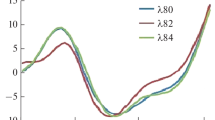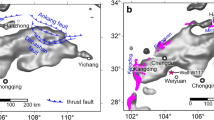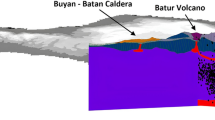Abstract
The China Seismo-Electromagnetic Satellite (CSES), China’s first satellite to measure geophysical fields with scientific goals in both space and solid earth physics, was launched successfully in February 2018. It carries high-precision magnetometers to measure the geomagnetic field. In this study, the CSES magnetic data were used to extract the signal of the lithospheric magnetic field caused by magnetized rocks in the crust and uppermost mantle. First, an along-track analysis of the CSES magnetic data was undertaken near the Bangui magnetic anomaly in central Africa and the Tarim magnetic anomaly in China, demonstrating that the CSES magnetic data are indeed sensitive to the lithospheric magnetic anomaly field. Then a lithospheric magnetic anomaly map over China and surrounding regions was derived. This map is consistent with the lithospheric part of the CHAOS-7 model. In particular, it clearly reveals four major magnetic anomalies containing long-wavelength signals at the altitude of low-earth-orbiting satellites. Three magnetic highs are located over the Tarim, Sichuan and Songliao basin, the origins of which could be related to large-scale tectonic-magmatic activities during geological history. A prominent magnetic low is otherwise found in the southern Himalayan-Tibetan plateau, possibly caused by the shallow Curie depth in this region. To further improve the precision of the lithospheric magnetic field model, more detailed data processing and multi-source data merging are needed.
Similar content being viewed by others
References
Langel R A, Hinze W J. The Magnetic Field of the Earth’s Lithosphere: The Satellite Perspective. Oxford: Cambridge University Press, 1998
Ferré E C, Friedman S A, Martín-Hernández F, et al. Eight good reasons why the uppermost mantle could be magnetic. Tectonophysics, 2014, 624–625: 3–14
Regan R D, Marsh B D. The Bangui magnetic anomaly: Its geological origin. J Geophys Res, 1982, 87: 1107–1120
Pilkington M, Saltus R W. The Mackenzie River magnetic anomaly, Yukon and Northwest Territories, Canada—Evidence for Early Proterozoic magmatic arc crust at the edge of the North American craton. Tectonophysics, 2009, 478: 78–86
Hinze W J, Allen D J, Fox A J, et al. Geophysical investigations and crustal structure of the North American Midcontinent Rift system. Tectonophysics, 1992, 213: 17–32
Ravat D, Langel R A, Purucker M, et al. Global vector and scalar Magsat magnetic anomaly maps. J Geophys Res, 1995, 100: 20111–20136
Regan R D, Cain J C, Davis W M. A global magnetic anomaly map. J Geophys Res, 1975, 80: 794–802
Arkani-Hamed J, Langel R A, Purucker M. Scalar magnetic anomaly maps of Earth derived from POGO and Magsat data. J Geophys Res, 1994, 99: 24075–24090
Purucker M, Langlais B, Olsen N, et al. The southern edge of cratonic North America: Evidence from new satellite magnetometer observations. Geophys Res Lett, 2002, 29: 8000
Hemant K, Maus S. Geological modeling of the new CHAMP magnetic anomaly maps using a geographical information system technique. J Geophys Res, 2005, 110: B12103
Maus S, Rother M, Holme R, et al. First scalar magnetic anomaly map from CHAMP satellite data indicates weak lithospheric field. Geophys Res Lett, 2002, 29: 45–1–47–4
Maus S, Rother M, Hemant K, et al. Earth’s lithospheric magnetic field determined to spherical harmonic degree 90 from CHAMP satellite measurements. Geophys J Int, 2006, 164: 319–330
Maus S, Lühr H, Rother M, et al. Fifth-generation lithospheric magnetic field model from CHAMP satellite measurements. Geochem Geophys Geosyst, 2007, 8: Q05013
Friis-Christensen E, Lühr H, Hulot G. Swarm: A constellation to study the Earth’s magnetic field. Earth Planet Sp, 2006, 58: 351–358
Thébault E, Vigneron P, Langlais B, et al. A Swarm lithospheric magnetic field model to SH degree 80. Earth Planet Sp, 2016, 68: 126
Olsen N, Ravat D, Finlay C C, et al. LCS-1: A high-resolution global model of the lithospheric magnetic field derived from CHAMP and Swarm satellite observations. Geophys J Int, 2017, 211: 1461–1477
Shen X H, Zhang X M, Yuan S G, et al. The state-of-the-art of the China Seismo-Electromagnetic Satellite mission. Sci China Tech Sci, 2018, 61: 634–642
Huang J P, Shen X H, Zhang X M, et al. Application system and data description of the China Seismo-Electromagnetic Satellite. Earth Planet Phys, 2018, 2: 444–454
Yang Y, Hulot G, Vigneron P, et al. The CSES Global Geomagnetic Field Model (CGGM): An IGRF type global geomagnetic field model based on data from the China Seismo-Electromagnetic Satellite. Earth Planets Space, 2021, 73: 45
Finlay C C, Kloss C, Olsen N, et al. The CHAOS-7 geomagnetic field model and observed changes in the South Atlantic Anomaly. Earth Planets Space, 2020, 72: 156
Thébault E, Purucker M, Whaler K A, et al. The magnetic field of the earth’s lithosphere. Space Sci, Rev, 2010, 155: 95–127
Pollinger A, Lammegger R, Magnes W, et al. Coupled dark state magnetometer for the China Seismo-Electromagnetic Satellite. Meas Sci Technol, 2018, 29: 095103
Pollinger A, Amtmann C, Betzler A, et al. In-orbit results of the Coupled Dark State Magnetometer aboard the China Seismo-Electromagnetic Satellite. Geosci Instrum Method Data Syst, 2020, 9: 275–291
Cheng B J, Zhou B, Magnes W, et al. High precision magnetometer for geomagnetic exploration onboard of the China Seismo-Electromagnetic Satellite. Sci China Tech Sci, 2018, 61: 659–668
Zhou B, Yang Y Y, Zhang Y T, et al. Magnetic field data processing methods of the China Seismo-Electromagnetic Satellite. Earth Planet Phys, 2018, 2: 455–461
Zhou B, Cheng B, Gou X, et al. First in-orbit results of the vector magnetic field measurement of the High Precision Magnetometer onboard the China Seismo-Electromagnetic Satellite. Earth Planets Space, 2019, 71: 119
Finlay C C, Olsen N, Kotsiaros S, et al. Recent geomagnetic secular variation from Swarm and ground observatories as estimated in the CHAOS-6 geomagnetic field model. Earth Planet Sp, 2016, 68: 112
Olsen N, Lühr H, Finlay C C, et al. The CHAOS-4 geomagnetic field model. Geophys J Int, 2014, 197: 815–827
Arkani-Hamed J, Zhao S K, Strangway D W. Geophysical interpretation of the magnetic anomalies of China derived from Magsat data. Geophys J, 1988, 95: 347–359
Zhang C D. Deduction of magnetic characteristics of lithosphere in China from results on satellite and aeromagnetic measurements. Progress Geophys, 2003, 18: 103–110
Kang G F, Gao G M, Bai C H, et al. Distribution of the magnetic anomaly for the CHAMP satellite in China and adjacent areas. Chinese J Geophys, 2010, 53: 895–903
Xiong S Q, Tong J, Ding Y Y, et al. Aeromagnetic data and geological structure of continental China: A review. Appl Geophys, 2016, 13: 227–237
Xiong S, Yang H, Ding Y, et al. Distribution of igneous rocks in China revealed by aeromagnetic data. J Asian Earth Sci, 2016, 129: 231–242
Wu G H, Li H W, Xu Y L, et al. The tectonothermal events, architecture and evolution of Tarim craton basement palaeo-uplifts. Acta Petrol Sin, 2012, 28: 2435–2452
Gao G, Kang G, Bai C, et al. Distribution of the crustal magnetic anomaly and geological structure in Xinjiang, China. J Asian Earth Sci, 2013, 77: 12–20
Wang J, Yao C, Li Z, et al. 3D inversion of the Sichuan Basin magnetic anomaly in South China and its geological significance. Earth Planets Space, 2020, 72: 40
Wang J, Yao C, Li Z. Aeromagnetic anomalies in central Yarlung-Zangbo suture zone (Southern Tibet) and their geological origins. J Geophys Res Solid Earth, 2020, 125: 1–24
Hemant K, Mitchell A. Magnetic field modelling and interpretation of the Himalayan-Tibetan Plateau and adjoining north Indian Plains. Tectonophysics, 2009, 478: 87–99
Qiu Y, Wang Z, Jiang W, et al. Combining CHAMP and swarm satellite data to invert the lithospheric magnetic field in the Tibetan Plateau. Sensors, 2017, 17: 238
Author information
Authors and Affiliations
Corresponding author
Additional information
This work was supported by the China Postdoctoral Science Foundation (Grant No. 2019M660731), the National Key R&D (Research and Development) Program of China (Grant No. 2018YFC1503500) and ISSI-BJ (International Space Science Institute-Beijing) (Grant No. 2019IT-33). Work by Gauthier Hulot and Nils Olsen was supported as part of Swarm DISC activities, funded by ESA (Grant No. 4000109587). Work by Angelo De Santis was supported by LIMADOU-Science Project, funded by ASI (Italian Space Agency). Work of Werner Magnes was supported by the Austrian Space Applications Programme (Grant No. 873688). This work made use of the data from CSES mission (http://leos.ac.cn), a project funded by the China National Space Administration (CNSA) and the China Earthquake Administration (CEA).
Rights and permissions
About this article
Cite this article
Wang, J., Shen, X., Yang, Y. et al. Initial scalar lithospheric magnetic anomaly map of China and surrounding regions derived from CSES satellite data. Sci. China Technol. Sci. 64, 1118–1126 (2021). https://doi.org/10.1007/s11431-020-1727-0
Received:
Accepted:
Published:
Issue Date:
DOI: https://doi.org/10.1007/s11431-020-1727-0




